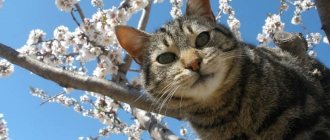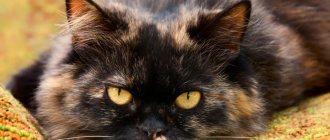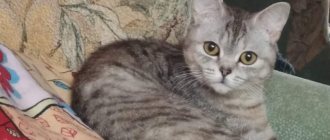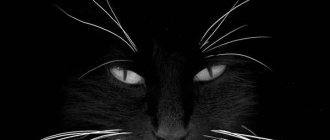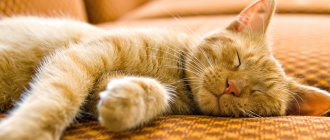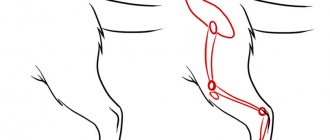Pets, and not only them, often get sick, and many of their diseases are similar to human ones. But a cat, unlike a person, during an illness cannot talk about its well-being or what is bothering it.
In this regard, the greatest responsibility lies with you, the owner, because you yourself must notice the cat’s dry nose, changes in activity, temperature or other problems.
Today we will talk specifically about dry nose in cats, the causes of this symptom, possible diseases and much more.
Causes of dry nose
First of all, you shouldn't worry about this right away. There are many more reasons why a cat has a dry nose than you might imagine, and not all of them are hazardous to health or simply problematic.
First, let's talk about the simplest and most ordinary situations that can occur every day, or even several times a day.
We are now talking about the simple time after sleep. The fact is that after sleep, cats' noses will always be a little dry and this is quite normal. In this case, the reasons for a cat’s dry nose lie in the fact that during sleep he simply does not lick it, which is why this happens.
The same story will happen with excessive activity, especially if it all happened in the fresh air and under the sun.Read here Leukosis in cats: main symptoms, what to do if detected, prognosis and diagnosis of the disease (130 photos)
In this case, both the environment and the cat’s own body temperature play an important role, which becomes noticeably higher during physical activity. We are not yet talking about additional factors, such as dust, strong wind, and so on.
The most interesting thing is that similar things can happen under normal conditions at home, especially in winter, when the cat lies for a long time near or even on the heating radiator.
It is not uncommon for cats to have a dry nose at fairly low temperatures. This happens because a cat instinctively stops licking its nose when the environment becomes too cold.
In this case, you should not think about whether the cat should have a dry or wet nose - it is better to wait until he gets into a more normal environment for an extended period of time.
Smell is everything to a cat
It all starts from the very first days of life. After all, newborn kittens are completely blind. How then do they unmistakably find the mother cat’s milk nipples? Of course, by smell. By smell, the mother cat herself distinguishes kittens from the same litter, and the kittens themselves distinguish each other and all surrounding objects.
Cats mark their territory using special odorous liquids that are secreted by glands on their faces and near their tails. This is why cats often rub their faces against objects. Including the owners, they also mark them as something that is located on their territory and is their property.
Cats find a cat that is ready to mate by smell, and cats find the cat that is most suitable for them. The smell also identifies whose territory the cat is currently in, or whether a stranger is present in his own possessions.
Parting with familiar smells causes quite a lot of stress in a cat. That’s why your pets have such a hard time going through moving, buying new furniture, and especially renovations. After all, if when moving or buying a new sofa the smells remain more or less natural, then during renovation the smells of paints and other building materials can simply drive the poor animal crazy. Therefore, during the period of reconstruction, it is better to take the cat to the dacha or to another house.
It should be noted that the shape of cat noses depends on the breed. It is clear that the nose of a Siamese or Siberian cat will be much larger than the nose of a Persian. And the hump nose of a Burmese cat can be safely described as aristocratic or “Roman”.
Should your nose be wet?
You forget that the cat is first and foremost a predator by nature. During the hunt, he needs to be able to determine the direction of the wind in order to sneak up on the prey unnoticed - in this regard, they are incredibly similar to relatives like a tiger or a cheetah, and for this they use their nose, which must be wet.
This is why you should understand what to do if your cat has a dry nose. In addition, a cat's nose also has more mundane tasks, such as simply determining the temperature of objects by approaching them.That is why, if for various reasons a cat’s nose is dry for a long time, it may begin to crack, and this promises not only simple discomfort, but also a disruption of the animal’s normal life.
External features of the breed
Most outbred cats correspond to one gold standard: medium-sized paws, medium-wide chest and rump, and a rounded head, crowning this standard splendor.
But we are talking about exceptions. So, what exceptional external characteristics bring a simple cat closer to a purebred cat?
Ears
A purebred aristocrat cat can be identified almost unmistakably by the shape of its ears:
American Curl breed with curled ears
- only the American Curl ;
- The ears hanging on deformed cartilage, folded in half and sometimes seeming to be stuck to the head belong to the Scottish Fold cat . However, a kitten of this breed can also be born straight-eared (Scottish Straight);
- Low-set, small, bent down and forward, ears that fit tightly to the head are found in the Highland Fold ;
- if only the very tips of the ears, devoid of any vegetation, droop forward (as if falling off), then we have a Ukrainian Levkoy ;
- The extravagant hairless elf has very large, open ears, widened at the base with smoothly curved back rounded tips;
- the large, handsome Maine Coon can be recognized by its large, triangular, pointed ears ending in characteristic tassels;
- the combination of floppy ears and curled fur distinguishes the poodlecat ;
- those with disproportionately large ears may belong to Abyssinians or Orientals .
Short tail
It is noteworthy that the presence of a tail in a “rudimentary” state or its complete absence in cats is a sign of “noble” origin (in contrast to the same domestic dogs, whose tails are docked deliberately - to fit the animals to the standards of a particular breed). It is worth noting that there are only a few types of short-tailed or tailless cat breeds, which include:
Cymrik tailless cat breed
- Cymrik is a breed without a tail at all. From the word absolutely. At the same time, Cymrics have short front legs and a peculiar jumping gait.
- Manx are another tailless purr. True, not all of them - according to the standard, Manxes either have no tail at all or show off with a very long one.
- Pixiebob is a mini-lynx that was bred in the 80s of the 20th century. The tail of domestic predators can sometimes be two centimeters long, and sometimes even 15 cm.
- The Kurilian Bobtail is a breed in which the genes of the Japanese Bobtail and Siberian cat are mixed, bred in Russia.
- The American Bobtail demonstrates its temperament with its tail, which reaches the base of its hind legs.
- The Japanese Bobtail is a classic representative of cats with short tails. According to the standard, the tail of a Japanese bobtail should, firstly, be no longer than 12 centimeters, and secondly, the tail must be curled.
Little paws
Oddly enough, “short legs” is a sign of thoroughbred pets, but all cats with similar limbs were bred exclusively artificially:
Breed of semi-hairless cat with short legs Minskin
- Minskin - short paws (of the same length below and above the knee joint), a rounded head with large, open and seemingly “alert” ears, thick and dense, but short hair, growing in islands (on the head, ears, limbs, tail) almost “ naked" body.
- Dwelf is a hairless cat obtained by crossing a Munchkin, a Canadian Sphynx and an American Curl. It is distinguished by short legs, a wedge-shaped head and elf ears.
- Bambino - short but muscular legs, a stretched oval-shaped body with a wide chest and a long thin tail, wide-set large ears (slightly tilted forward) located on a medium-sized head, a visible lack of hair (although light corduroy fluff is allowed).
- Skookum has short but strong legs (the front ones are slightly shorter than the hind ones), a compact and dense body with rounded contours of the head and a long tail of medium thickness, curly hair (can be short or long).
- Munchkin - short straight legs (the hind legs may be slightly longer than the front ones), a medium-sized body with well-developed muscles, a thick neck and a wide wedge-shaped head, short or long hair.
- Napoleon - neat short paws, a small but strong body with massive bones and a long tail, a rounded head with a flattened muzzle and huge round eyes separated by a short nose, short or long, but always thick hair.
Action plan
If you find a dry nose in your cat, then the first thing you need to do is be patient and watch it for a day or two.
In this case, you will have the most complete picture possible, both about his behavior and regarding other possible symptoms.
If even with a dry nose, the cat’s general behavior does not change - he is very active, sleeps enough, eats well, then most likely you can dispel your worries about this.
But you must understand that even in a situation where you find a dry nose, which has begun to crack, you should not try to smear it with anything.
Getting rid of the causes of such a problem will in itself begin to return everything to normal - the cracks will heal, and the cat will lick its nose and restore the required level of humidity.
Ringworm in cats - main signs, symptoms, prevention and treatment of ringworm in cats (105 photos)- Pancreatitis in cats: first symptoms, nutritional nuances and treatment options (125 photos and videos)
Subcutaneous mites in cats - first symptoms, treatment options and real photos of examples of parasite damage (110 photos + video)
Photo of a cat's nose
Help the site, share with friends

